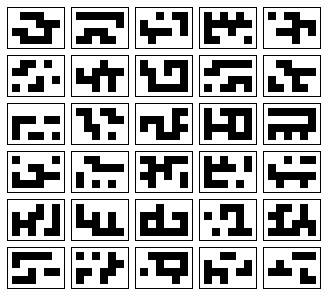Weekly Update 6: Symbols, Sounds, and Mantras
2023-07-24
This past week, I found myself thinking about symbols, sounds, and Mantras.
Mantra
To begin, a small compositional sketch with some graphics to accompany it:
I call this a Mantra because the sound is a looping pattern. The pattern is less obvious because the tempo of the pattern keeps changing. This is a trick I sometimes use to add more variation where there is none.
The visuals act as a kind of "score" for the sound. It depicts 6 symbols, where each symbol corresponds to a phoneme in the sound. The performance plays two phonemes, then slides between them. If the symbols were represented as ABCDEF, then the performance could be notated as AB A~B CD C~D EF E~F.
This may not sound like much, but it represents a culminiation of the work I've been doing over the past few weeks.
Sounds
The vocal-like sounds heard above use the new computer simulation of the vocal tract I've been developing (more frequently known as a "physical model" of the vocal tract). One of the new things I can do with this tract is adjust its length: a longer tract yields a voice that sounds like it is coming from a bigger thing. As a result, this is a voice that is both large and deep in pitch.
This voice sounds a bit like Throat Singing, and in many ways the approach is very similar to that vocal technique. Throat Singing puts a large amount of focus in the shaping of the vocal tract to produce timbre. The Voice here also puts a great deal of attention into change the shape of its virtual vocal tract. In fact, that is the only thing being changed here. The pitch remains constant, and it doesn't ever pause or turn off. By changing the vocal tract shape, different vowel sounds emerge.
Dynamic vocal tract shaping is done by taking a set of premade shapes, and then smoothly blending between them in time. The timing characteristics of the blending are determined using Gesture Synthesis, which is a very important topic, but not one for this Blog post.
Vocal tract shapes are "sculpted" interactively using a tool I built, which was the focus of what I worked on last week. This week, I added the ability to load and save shapes. Using this tool, I was able to make 6 distinct tract shapes, which are used in the Mantra above.
Symbols
The ability to load and save shapes with the interactive tract sculpter comes with some new design issues to solve. First, what do you call any given shape? Some of these shapes sound like familiar vowels like "ah", and "oh", but many more are a bit more in between sounds. Secondly, once you come up with a name, how do you effectively display it on the grid? The Grid has low information density. Even drawing a single letter on the grid could take up almost half of the screen space.
One possible way to address the first problem is to simply automate the naming process. Since trying to properly label these sounds is mostly an arbtirary association, just have a computer program write one up. This saves quite a bit of work, because now there doesn't need to be a system to input in a label.
To solve the second issue, I built klover, an algorithmic way to produce aesthetically pleasing symbols that also fit well on the grid. By condensing a shape's name down to a symbol, one maximizes the amount of information that can be displayed on the Grid at once.

This work is directly inspired by Square Kufic Calligraphy, which I've explored in previous projects such as Kuf and Trikuf.
What's Next?
I'm putting sound aside for a few weeks yet again. I will be focusing on things related to story and narrative, as well as some map design.
That's all I got to say for now.